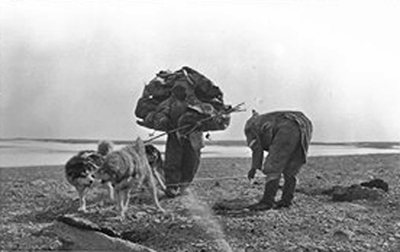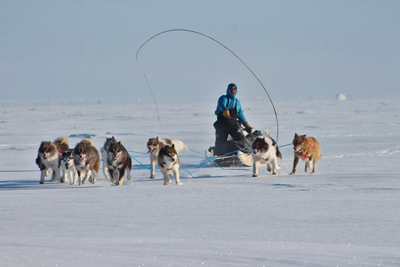From the Editor: Of Sledge Dogs and Bulldogs
The Qimuksiq Network
A Hunt for the Greenlandic Sled Dog’s Soul
The Arctic Nomads Post-Symposium Report
Bulldog with a Short Snout
Book Review: The World of Tivi Etok
IMHO: Staying the Path
Navigating This Site
Index of articles by subject
Index of back issues by volume number
Search The Fan Hitch
Articles to download and print
Ordering Ken MacRury's Thesis
Our comprehensive list of resources
Defining the Inuit Dog
Talk to The Fan Hitch
The Fan Hitch home page
Editor: Sue Hamilton
Webmaster: Mark Hamilton
The Fan Hitch, Journal
of the Inuit Sled Dog, is published four
times a year. It is available at no cost
online at: https://thefanhitch.org.
The Fan Hitch welcomes your letters, stories, comments and suggestions. The editorial staff reserves the right to edit submissions used for publication.
Contents of The Fan Hitch are protected by international copyright laws. No photo, drawing or text may be reproduced in any form without written consent. Webmasters please note: written consent is necessary before linking this site to yours! Please forward requests to Sue Hamilton, 55 Town Line Rd., Harwinton, Connecticut 06791, USA or mail@thefanhitch.org.
This site is dedicated to the Inuit Dog as well as related Inuit culture and traditions. It is also home to The Fan Hitch, Journal of the Inuit Sled Dog.
The Fan Hitch welcomes your letters, stories, comments and suggestions. The editorial staff reserves the right to edit submissions used for publication.
Contents of The Fan Hitch are protected by international copyright laws. No photo, drawing or text may be reproduced in any form without written consent. Webmasters please note: written consent is necessary before linking this site to yours! Please forward requests to Sue Hamilton, 55 Town Line Rd., Harwinton, Connecticut 06791, USA or mail@thefanhitch.org.
This site is dedicated to the Inuit Dog as well as related Inuit culture and traditions. It is also home to The Fan Hitch, Journal of the Inuit Sled Dog.
IMHO....

Ikpukkuak releases his three dogs for packing while Higilaq sets out
with her backpack near Ammalurtuq Lake, southwest Victoria Island;
1 July 1915, N.W.T. (Nunavut).
Courtesy, Canadian Museum of Civilization;
#36989, CD95-927-025;
Diamond Jenness photo
Staying The Path
by Mark Hamilton
From time to time I like to re-examine my basic premises. It just requires some quiet moments of self-reflection. Other times there is something that obliges me to do this. Most recently I was so compelled by Guvener Isik’s excellent “Bulldog with a Short Snout”, which appears in this edition of The Fan Hitch. I hope you’ve already taken the time to read it.
I’m going to tell you about where my reflections went wandering after reading the piece because Isik’s position and insight into keeping an aboriginal landrace animal dovetails so well with other information we’ve learned in the last several years.
I need to quote myself now. In my IMHO in the June 2013 edition of The Fan Hitch, writing about taxonomic naming I said:
Starting in March 2009, The Fan Hitch published in four parts Vladimir Beregovoy’s work “Evolutionary Changes In Domesticated Dogs: The Broken Covenant Of The Wild”. Beregovoy’s article delineated many differences between aboriginal dogs and cultured breeds while defining the term: aboriginal. Further, he presented models of their reproductive biology, behavior, way of life and selection, then contrasted them with that of cultured breeds. Johan and Edith Gallant’s article, “Breed, Landrace and Purity: what do they mean?” was published in the December 2010 edition of The Fan Hitch. The article presented definitions for the terms landrace and breed as well walked us through the concept of purity. Landrace dogs (aboriginal dogs) were described as unique to their ecology/geography as well as their uses. While some human influence was acknowledged in terms of preference, they were described as, “largely the result of environmental adaptation, mostly under conditions of natural selection.” Beregovoy’s and the Gallant’s articles highlight the unique position aboriginal dogs (landrace dogs) occupy between the feral wolf and cultured dog breeds and perhaps even account for the interest various researchers have lately expressed in landrace dogs in their search for the origin of dog domestication.Then, in my March 2015 IMHO:
In 2005 Hanne Friis Andersen’s research – based on mtDNA collected from of blood samples – proved the Canadian Inuit Sled Dog and the Greenland Husky were the same landrace.In terms of knowledge gained, the last ten years have been wonderful for the Inuit Dog. A great deal of information was developed about what the Inuit Dog is as well as the people who kept it, where it came from and how it migrated across the polar north. Now Guvener Isik brings us information about the requirements, the necessities which must to be met to maintain the aboriginal Inuit Dog as a landrace as well as the process required to prevent it from becoming just another cultured breed.
In Sarah Brown’s early 2013 research – a comparison of ancient dog mtDNA to modern – we learned today’s Inuit Dog carries the same unique gene sequence (A31) that her research traced back into antiquity. Interestingly, her research also found that the Alaskan Malamute (a cultured breed whose real history, as such, began with American Kennel Club registration in 1935) typically demonstrated a different sequence (A29) which it shared with the Siberian Husky. Only one of the twenty-six Alaskan Malamutes tested carried the A31 sequence.
Later in 2013, Peter Savolainen’s research – based on mtDNA collected from hair samples – confirmed that Inuit Dogs (Canadian Inuit Sled Dog, Greenland Husky, Canadian Eskimo Dog) carried the A31 genotype and we learned that the dog was free from contamination by European dogs DNA, at least on its maternal side.
Andersen, Brown and Savolainen’s research enhanced our knowledge of what the Inuit Dog is and how it got to this point. The ISD is an ancient landrace. It is one of just a few dogs that are confirmed to have been part of the New World’s ecology prior to the introduction of European influence and genetic presence. It is special. It is unique. And it remains to this day a landrace true to its function. It has its own unique history.
By way of example take this quote where he warns about the cost of replacing a landrace with a cultured breed variant, “…creating a breed or breeds out of a landrace population, which has no starting and ending point, is fundamentally wrong since doing so will result in the abolishment of the entire landrace population with all its subgroups and varieties.”
Also, in terms of the “nuts and bolts” required for carrying the Inuit Dog forward as a landrace animal this quote was a concise eye-opener for me, “What made a group of organisms good is needed to continue to make them good. In this regard, epigenetics is more explanatory than basic Mendelian genetics. The real conservation is not freezing, multiplying or replicating, but it is keeping the process that led to the organism to be conserved alive.”
So, this brings us to a question we all need to answer: When we utilize all the information in the above referenced articles, integrate them as a single body of knowledge and use it to shape our behavior and actions as they relate to maintaining the Inuit Dog and create the future generations, where are we now?
In all honesty, it seems to me that Bill Carpenter’s statement in a long ago issue of the Yellowknife Journal: ''The future of this dog is not with southern dog shows, not with pet owners on leashes. The future of this dog lies in its cultural setting. The future of the dog is in the hands of the northerners,'' has never sounded more right.

On the way photo: Joelie Sanguya